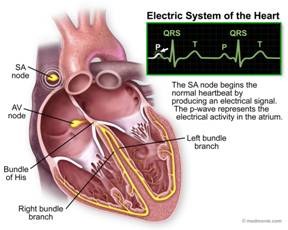The Heart’s Electrical System
The heart contains an electrical system that creates the electrical signals that trigger the heart to contract or beat. With each contraction, blood is pumped to the entire body. The process begins in the atria, the upper chambers of the heart, which pump blood into the ventricles, the lower chambers that then pump blood throughout the body. This coordinated action occurs due to the heart’s wiring that sends electrical signals to the four chambers of the heart to tell it to contract.
The Heartbeat
Most of the time, people are not aware of their heartbeat. When exercising however, you may notice the pulse in your chest or neck becomes rapid and strong. Your heartbeat is able to slow down and speed up because it is wired with electrical tissue, similar to the wires that connect a television. Your heart also has its own pacemakers that can be imagined as electrical outlets. The pacemaker cells send signals that tell the heart muscles to contract.
The heart would not pump blood and contract without the electrical system. Blood would not circulate throughout the body and not receive the oxygen and nutrients it needs. When blood stops flowing to the brain, a person will lose consciousness in seconds and death will follow within minutes.
How the Heart is Wired
You may have heard of someone with an artificial pacemaker that regulates heart beats. Pacemakers and their wiring coordinate contractions in the lower and upper chambers, which makes the heart beat properly.
In normal hearts, a natural pacemaker that tells the heart when to beat is present. The master pacemaker called the sinoatrial (SA), or sinus node is located in the right atrium and acts like a spark plug that fires in a rhythmic, regular pattern to regulate the heart’s rhythm. It sends signals to the rest of the heart so the muscles will contract properly.
First, as soon as the signal is sent, the atrium contracts. The electrical signal from the sinus node spreads through the atria, like a pebble dropped into a pool of water. Next, the signal travels to the area that connects the atria with the ventricles. This connection is critical because without it, the signal would never reach the ventricles, the main pumping chambers of the heart.
The electrical signal then reaches another natural pacemaker called the atrioventricular node (AV node). As the signal continues and crosses to the ventricles, it passes through the bundle of His. The bundle divides into wire-like thin structures called bundle branches that extend into the left and right ventricles. The electrical signal travels down the bundle branches to thin fibers. Finally, these fibers send out the signal to the muscles of the ventricles, which cause them to contract and pump blood into the arteries.
In a normal heart, these electrical signals occur about once every second, and maintains the steady, rhythmic pattern of the heart’s beat.


